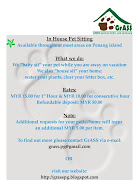Sunday August 23, 2009
By CHIN MUI YOON
The swiftlet that creates those much-in-demand edible nests are indigenous to this part of the world. We even have a long history of collecting the nests for consumption dating back to the last century. So why aren't we doing as well as our neighbours in making money from this natural resource?
FORTUNES can be made harvesting the bounty of the earth or sea. But if you farm birds' nests, your fortune lies in the skies.
Every evening, such farmers all over the country eagerly turn their eyes upwards, hoping to see swiftlets entering the "caves" that are their farms, which are actually converted shoplots or custom-built bungalows.
The saliva produced by these swiftlets – of the species Aerodramus fuciphagus – to form their nests is considered one of the five elite foods highly prized by the Chinese; the others are abalone, fish maw, ginseng, and shark's fin. All of these foods fetch lucrative prices.
In fact, while the price of gold and other commodities has fluctuated throughout the last century, the price of edible birds' nests has simply grown steadily higher. From US$10 a kilo in 1975, prices soared to US$400 in 1995. In 2002, a kilo cost US$1,600 (RM5,600) and today, the nests can go for up to US$2,700 (RM9,450) a kilo!
The industry in Malaysia alone commands RM1bil annually, according to the 2007 Malaysian Swiftlet Farming Industry Report by Hameed Sultan Merican, former chairman of the agricultural and agro-based businesses sub-committee of the SMI Association of Penang.
The report notes that a kilogramme of top quality, unprocessed nests (which works out to about 90 to 120 nests) fetched between RM4,500 and RM6,000 in 2006. After processing, retail prices went as high as RM15,000 to RM25,000 per kilo.
It helps that China, the largest market for edible birds' nests, cannot produce its own supply, as these non-migratory birds reside only in South-East Asia. Breeding them doesn't work, as it results in genetic mutations.
Indonesia commands the lion's share of the market at 70%, followed by Thailand at 20% with Malaysia trailing in at 6%.
The Malaysian Government has noted this promising market. Both Prime Minister Datuk Seri Najib Tun Razak and his deputy, Tan Sri Muhyiddin Yassin, have encouraged entrepreneurs to venture into this industry.
Chairman of the Malaysian Federation of Associations of Birds Nests Merchants Datuk Beh Heng Seong says Malaysia has the potential to increase its current production level three to five times.
"Studies show that Indonesia is saturated," he said at an interview last week. "Malaysia still has the capacity to grow.
"Prices fell by nearly half in November last year due to negative economic sentiments, but there's still a strong demand in China. Whether they have ever consumed a bird's nest or not, all Chinese know the words 'birds' nest'!"
Universiti Putra Malaysia Assoc Prof (of the Nephrology Department) Dr Christopher Lim, 36, agrees. The kidney specialist became fascinated with swiftlet farming when he came across mention of it at an agricultural exhibition in Johor Baru in 2004.
"Malaysia can easily raise its market share, as we are located right in the middle of the swiftlets' breeding grounds," he says.
Dr Lim is now a noted swiftlet authority, author of the popular Make Millions from Swiftlet Farming: A Definitive Guide (Publisher: TrueWealth Sdn Bhd, ISBN: 9833364721), and presenter of well-attended seminars on the subject.
The doctor belongs to a new breed of farmer that enthusiastically advocates a more professional development of this industry led by farmers equipped with the correct knowledge and ethical practices.
"Swiftlet farming is perfectly legal after you've obtained permits from local councils and have attended a Veterinary Services Department course," explains Dr Lim.
Farmers must also adhere to the department's Good Animal Husbandry Practices Guide. Other rules apply, like using only non-residential areas and not using heritage buildings.
"A swiftlet landlord can generate RM10,000 to RM20,000 from a standard 20x70-foot (6m x 20m) shoplot by harvesting 2kg to 4kg of birds' nests monthly!" says Dr Lim.
"But I would only encouage swiftlet farming if you're hands-on and armed with the correct knowledge because the failure rate is 70% to 80%!"
A potential gold mine
The high risk of failure hasn't deterred more people from venturing into the industry of late. Gone are the days when swiftlet farmers were retirees with free time. Many in today's industry are educated professionals seeking an alternative or additional source of income.
A sign of this industry's growing popularity here is the fact that Dr Lim's monthly seminars, which he bases on research and observation, are always fully booked. Participants come from throughout Malaysia as well as from Indonesia, Taiwan, and Thailand, all hoping to unlock the secrets of swiftlet farming.
We attend one seminar where we meet a young IT engineer called Kent Ho who has flown in all the way from California.
"Swiftlet farming is a young but promising industry in my homeland of Vietnam," he says. "I hope to start a farm in Danang, a coastal town south of Hanoi that has potential. It was hard getting solid information on starting out so I'm grateful for this seminar."
Another participant is Malaysian Dr Mahmood Kechik, an urologist who is building a five-storey "bird bungalow" in his hometown of Kelantan.
"I've been monitoring the growth of swiftlet farming for four years and I'm convinced there's potential. Previously, only royalty could enjoy this delicacy. Nowadays, every Chinese can consume birds' nests, so there is a huge demand," he says, adding with a laugh that, "studies show that birds' nests can benefit pregnant mothers and are also an aphrodisiac!"
Manjung, a small town in Perak, has experienced an exponential boom in swiftlet farming; so much so that the world's first custom-built accommodation for swiftlets was put up last year.
"We sold all 36 units, some even before we launched the project," says Loke Yeu Loong, managing director of the Perak Swiftlet Eco Park, which was jointly developed by the Perak State Development Corp and Bio Research Centre (M) Sdn Bhd.
The 7m x 22m (25x75 foot) units, built into a three-storey structure, are priced at RM398,000 each; also available are 18 units of 18m x 32m (60x105 foot) three-storey, semi-detached houses costing RM678,000 each.
"We have identified new sites throughout Malaysia; one each in Pahang, Negri Sembilan, and Selangor; two in Johor; and three in Terengganu. We had thought of venturing into Thailand and Vietnam, but Malaysia will keep us busy for five years!"
Consumer concerns
Despite the viability of swiftlet farming, the industry is clouded in controversy in Malaysia. This is largely due to bad practices by ignorant and irresponsible farmers, and a prevailing idea that consuming birds' nests is cruel and unhygienic.
Magazine editor Susie Chong, 34, recalls that she was ticked off by an irate reader after writing that she maintains good health and skin by eating birds' nests.
"This lady angrily asked me, 'How can you be so cruel as to eat birds' nests? Where are the poor baby birds going to stay?'," Chong says.
This is where ethical practices play their part, says Dr Lim.
It is actually in the farmer's interest to not disturb a nest with young in it; swiflets, like turtles, have a habit of returning to the same place they were born in to breed. By ensuring baby birds grow up safely and leave the nest, a farmer can encourage several generations of the birds to nest in his farm.
What of hygiene concerns? As the birds do not defecate in the nests, and that their food source is insects, this really shouldn't be a worry, says the doctor. Besides, to eat the nests, one has to double boil them.
Some people also have environmental concerns, as the swiflets are a protected species.
However, Dr Lim adds that farmers are actually doing their bit to preserve the birds by offering alternative breeding grounds to those in the wild that are slowly being eroded by development.
But some are unethical, he admits: "Some farmers wanting to get rich quickly harvest the nest before the eggs are laid, in hopes that the poor mother bird will create a new one. This is silly and risky not to mention being unethical to a creature that is enriching you."
The doctor has created his own principles for bird nest farming, which he teaches to all his seminar participants: I will not harvest nests that have eggs inside; I will not harvest nests with young birds inside; and I will not cause any form of physical or psychological harm to the birds.
Another common complaint is the noise caused by the artificial chirping relayed through speakers to attract birds to nest.
"I always enjoyed returning to my hometown, Tanjung Sepat (Selangor), for its sea breeze and good food," says engineer Martin Khoo, 40. "Lately, though, I was horrified to find that many of the upper floors of the shoplots in town, and even some houses, have been converted into swiftlet hotels!
"The chirping goes on incessantly even in the middle of the night. And it's very unpleasant to tuck into bah-kut-teh while birds fly endlessly above your head," he says crossly.
Loke of the Perak Swiftlet Eco Park points out that his company believes in housing bird farms on the outskirts of town to help lessen such complaints.
Lack of guidelines
Of course, it would help if there are guidelines to ensure that farms are sited where they won't be a nuisance.
Even if there were, though, they would be difficult to enforce because no one knows exactly how many farms exist. Different sources give figures ranging from 25,000 to 40,000.
Many are unlicensed, poorly designed, and located incorrectly in residential areas or in heritage buildings.
Though it's not surprising so many farms are unlicensed; Loke, from Perak's eco park, points out that there are too many government departments, agencies, and local councils involved.
Beh, of the association of birds' nests merchants, says there is a clear need for comprehensive guidelines applicable in every state in Malaysia. For instance, a yearly business license in Ipoh is RM120 while in Rompin, Pahang, it costs RM1,200.
Another problem that constrains this industry is that swiftlets are a protected species and, technically, their nests cannot be exported without a license. So most farmers sell their nests to middlemen and cannot reap the full profits.
Even tourists who buy nests legally from retailers cannot take them out of the country – some have had nests confiscated at airports. They must apply for permits from Perhilitan, which can take up to four days to process. And they cost RM200, with an additional export duty of RM100 per kilo.
"It's ridiculous, isn't it? Why would tourists want to go through that hassle?" points out Beh. "How can we encourage the purchase of Malaysian-made products when we have rulings like this?
"Surely it's about time new regulations are made to accommodate this industry's potential in modern times?"
Many people are also afraid that swiftlet farms will cause or spread bird flu.
But Dr Lim is quick to jump to the defence of his favourite birds: "No health official anywhere in the world has ever found a single strain of avian flu virus among swiftlets."
He adds that, "Studies have shown that places that have swiftlet farms have reported fewer incidences of dengue fever. A well-run farm has no mosquitoes, as swiftlets consume insects.
"Swiftlets are very clean creatures. They are non-migratory and do not share food or water with other animals. They drink water droplets from the air (hence their penchant for nesting in humid caves) and feed on flying insects.
"I hope more professionals will speak up for swiftlet farming to add credibility to this industry.Knowledge and responsible farming will go far to ensure greater success in this industry."
Related Stories:Are they really healthy?
Farming nests
Home sweet home
This article was taken from: The Star Online: Lifestyle: Focus 23 August 2009











No comments:
Post a Comment